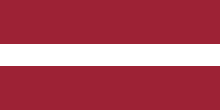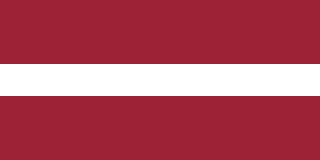
Latvia, officially the Republic of Latvia is a country in the Baltic region of Northern Europe. It is one of the three Baltic states, along with Estonia to the north and Lithuania to the south. It borders Russia to the east, Belarus to the southeast, and shares a maritime border with Sweden to the west. Latvia covers an area of 64,589 km2 (24,938 sq mi), with a population of 1.9 million. The country has a temperate seasonal climate. Its capital and largest city is Riga. Latvians belong to the ethnolinguistic group of the Balts and speak Latvian, one of the only two surviving Baltic languages. Russians are the most prominent minority in the country, at almost a quarter of the population.

The history of Latvia began around 9000 BC with the end of the last glacial period in northern Europe. Ancient Baltic peoples arrived in the area during the second millennium BC, and four distinct tribal realms in Latvia's territory were identifiable towards the end of the first millennium AD. Latvia's principal river Daugava, was at the head of an important trade route from the Baltic region through Russia into southern Europe and the Middle East that was used by the Vikings and later Nordic and German traders.

The Latvian National Armed Forces, or NBS, are the armed forces of Latvia. Latvia's defense concept is based on a mobile professional rapid response force and reserve segment that can be called upon relatively fast for mobilization should the need arise. The National Armed Forces consists of Land Forces, Naval Forces, Air Force and National Guard. Its main tasks are to protect the territory of the State; participate in international military operations; and to prevent threats to national security.

Rīga is the capital, primate, and the largest city of Latvia, as well as the most populous city in the Baltic States. Home to 609,489 inhabitants, the city accounts for a third of Latvia's total population. The population of Riga metropolitan area, which stretches beyond the city limits, is estimated at 860,142. The city lies on the Gulf of Riga at the mouth of the Daugava river where it meets the Baltic Sea. Riga's territory covers 307.17 km2 (118.60 sq mi) and lies 1–10 m (3–33 ft) above sea level on a flat and sandy plain.
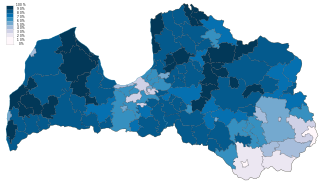
Latvian, also known as Lettish, is an East Baltic language belonging to the Indo-European language family. It belongs to the Baltic subbranch of the Balto-Slavic branch of the family and it is spoken in the Baltic region. It is the language of Latvians and the official language of Latvia as well as one of the official languages of the European Union. There are about 1.2 million native Latvian speakers in Latvia and 100,000 abroad. Altogether, 2 million, or 80% of the population of Latvia, spoke Latvian in the 2000s, before the total number of inhabitants of Latvia slipped to 1.8 million in 2022. Of those, around 1.16 million or 62% of Latvia's population used it as their primary language at home, though excluding the Latgale and Riga regions it is spoken as a native language in villages and towns by over 90% of the population.

Baltic Germans are ethnic German inhabitants of the eastern shores of the Baltic Sea, in what today are Estonia and Latvia. Since their resettlement in 1945 after the end of World War II, Baltic Germans have markedly declined as a geographically determined ethnic group in the region.
Latvian mythology is the collection of myths that have emerged throughout the history of Latvia, sometimes being elaborated upon by successive generations, and at other times being rejected and replaced by other explanatory narratives. These myths, for the most part, likely stem from Proto-Indo-European practices and the later folk traditions of the Latvian people and pre-Christian Baltic mythology.

Liepāja is a state city in western Latvia, located on the Baltic Sea. It is the largest city in the Kurzeme Region and the third-largest in the country after Riga and Daugavpils. It is an important ice-free port.

The Baltic states or the Baltic countries is a geopolitical term encompassing Estonia, Latvia, and Lithuania. All three countries are members of NATO, the European Union, the Eurozone, and the OECD. The three sovereign states on the eastern coast of the Baltic Sea are sometimes referred to as the "Baltic nations", less often and in historical circumstances also as the "Baltic republics", the "Baltic lands", or simply the Baltics.

Daugavpils is a state city in southeastern Latvia, located on the banks of the Daugava River, from which the city derives its name. The parts of the city to the north of the river belong to the historical Latvian region of Latgale, and those to the south lie in Selonia. It is the second-largest city in the country after the capital Riga, which is located some 230 kilometres northwest.

Latvians are a Baltic ethnic group and nation native to Latvia and the immediate geographical region, the Baltics. They are occasionally also referred to as Letts, especially in older bibliography. Latvians share a common Latvian language, culture, history and ancestry.
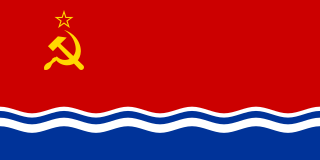
The Latvian Soviet Socialist Republic, also known as Soviet Latvia or simply Latvia, was de facto one of the constituent republics of the Soviet Union between 1940–1941 and 1944–1990.

The Latvia national football team represents Latvia in men's international football, and is controlled by the Latvian Football Federation, the governing body for football in Latvia. They have never qualified for the FIFA World Cup, but did qualify for the European Championship in 2004 under head coach Aleksandrs Starkovs.

The Latvian Football Federation ) is the governing body of football in Latvia with its headquarters located in the capital Rimi Sports Centre in Riga. Its activities include the organizing of the Latvian football championship, the Latvian First League, the Latvian Second League, as well as lower league championships and the Latvian Football Cup. The federation also manages the Latvia national football team and Latvia women's national football team.
Latvian cuisine typically consists of agricultural products, with meat featuring in most main dishes. Fish is commonly consumed due to Latvia's location on the eastern shore of the Baltic Sea.
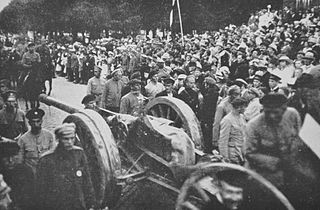
The Latvian War of Independence, sometimes called Latvia's freedom battles or the Latvian War of Liberation, was a series of military conflicts in Latvia between 5 December 1918, after the newly proclaimed Republic of Latvia was invaded by Soviet Russia, and the signing of the Latvian-Soviet Riga Peace Treaty on 11 August 1920.
Many Latvians resisted the occupation of Latvia by Nazi Germany. Independent Latvia had been occupied by the Soviet Union in June 1940, then by Nazi Germany in July 1941, forming Generalbezirk Lettland. The Latvian resistance movement was divided between the pro-independence units under the Latvian Central Council and the pro-Soviet units under the Central Staff of the Partisan Movement in Moscow. Daugavpils was the scene of fierce Jewish resistance during the Holocaust. Many local Latvians were actively involved in the resistance movement against the ethnic policies of the German occupation regime. 134 Latvians were later honored with the title Righteous Among the Nations, among them is Žanis Lipke, who risked his life to save more than 50 Jews.
The COVID-19 pandemic in Latvia was a part of the worldwide pandemic of coronavirus disease 2019 caused by severe acute respiratory syndrome coronavirus 2. The virus was confirmed to have reached Latvia on 2 March 2020, having been brought along with people returning from abroad.
